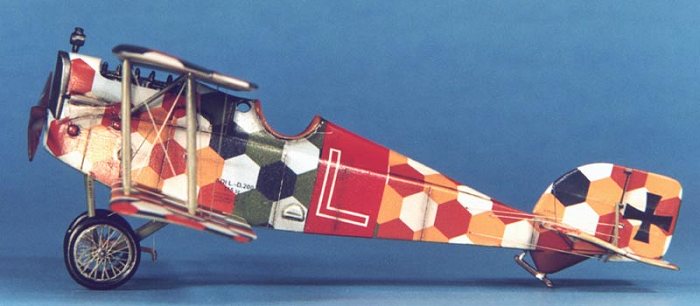
Flashback 1/48 Aviatik D.1 "Berg"
|
KIT: |
Flashback 1/48 Aviatik D.1 "Berg" |
|
KIT # |
KLH 89-22 |
|
PRICE: |
$34.98 |
|
DECALS: |
See review |
|
REVIEW & |
|
|
NOTES: |
|

|
HISTORY |
One of the "forgotten" fronts during WWI was the Italian Front. This front was a battle primarily between Austro-Hungarian (AH) and Italian troops with over 1,000,000 men killed during the Great War. Geography was the dominant theme in this front, with mountains covering the 400 mile length of the Italian Front. Mountain warfare was fought in the Dolomites, Carnic Alps, and Julian Alps in which avalanches were one of the most dangerous weapons of war. The fighting was particularly intense and deadly along the Isonzo River, where the Italians suffered approximately half of their casualties during the war. No less than 12 battles were fought in this scenic river valley sandwiched on the edge of the Julian Alps, culminating in the famous battle for Caporetto in which over 800,000 Italian troops had been lost to death, wounds, capture, or desertion effectively eliminating the Italian Second Army while AH losses were approximately 5,000.
The aircraft modeled is one flown by AH ace Frank Linke-Crawford who posted a total of 27 victories over the Italian Front before being shot down and killed on 30 July 1918 by two Italian Hanriot fighters.
|
THE KIT |
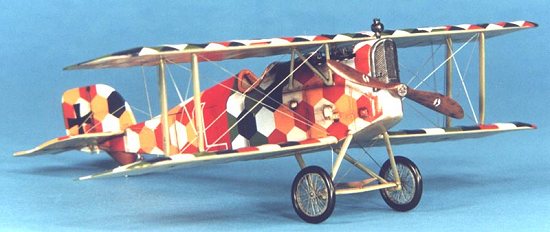 The kit is Flashback’s
1:48 Aviatik D.I "Berg". It is generally considered to be a limited
run kit (due to the low production run) however the quality of the injection
molding is very good, as it was produced by the same folks that produce current
Eduard kits. Therefore, I do not consider this to be a "limited run"
kit, as the quality is far above what one normally sees. This is a true
multi-media kit featuring injected molded plastic parts (23 parts), finely cast
resin parts (3 items) (engine), a simplified P/E sheet (12 items) (including
wire wheels!), and a complete A-H lozenge decal set along with markings for one
aircraft flown by Frank Linke-Crawford. The instruction sheet is an eight-page
fold-out diagram assembly with marked color painting guidelines and a full
rigging diagram (yaaaay!).
The kit is Flashback’s
1:48 Aviatik D.I "Berg". It is generally considered to be a limited
run kit (due to the low production run) however the quality of the injection
molding is very good, as it was produced by the same folks that produce current
Eduard kits. Therefore, I do not consider this to be a "limited run"
kit, as the quality is far above what one normally sees. This is a true
multi-media kit featuring injected molded plastic parts (23 parts), finely cast
resin parts (3 items) (engine), a simplified P/E sheet (12 items) (including
wire wheels!), and a complete A-H lozenge decal set along with markings for one
aircraft flown by Frank Linke-Crawford. The instruction sheet is an eight-page
fold-out diagram assembly with marked color painting guidelines and a full
rigging diagram (yaaaay!).
|
CONSTRUCTION |
 I started with my
usual warm, dish soap water wash of the plastic, resin, and photo-etch
components and followed with a cold water rinse. Pat dry with a paper towel and
let dry overnight. The wash does really help, especially on the resin and
photo-etch parts. I then pre-painted all the parts as indicated in the
instructions.
I started with my
usual warm, dish soap water wash of the plastic, resin, and photo-etch
components and followed with a cold water rinse. Pat dry with a paper towel and
let dry overnight. The wash does really help, especially on the resin and
photo-etch parts. I then pre-painted all the parts as indicated in the
instructions.
For a change, assembly did not start with the cockpit but the engine! Be very careful when installing the completed engine to its mount, make sure you get everything aligned along the centerline EXACTLY (this is not easy as I found out later!). I also wrapped the engine in Parafilm to prevent overspray. Next up was the cockpit. No significant difficulties were encountered here except some of the PE bulkheads required a little filing off the sides in order to fit within the fuselage. After closing up the fuselage by gluing the two halves together I noticed that I missed by just a hair in lining up the engine along the centerline. Boy, I sure thought I had that sucker dead-on when I first put it in! Next I drilled and dry-fitted all of the rigging, strut, and landing gear mounting holes to assist in final assembly as nothing is more frustrating as trying to get these pieces together with a fragile model. After stuffing some wet tissue paper into the cockpit opening, it was off to the paint shop (more realistically the decal shop!).
|
PAINT & DECALS |
The paint scheme is very simple; a clear doped linen (CDL) undersurface as most of the model is decals. I used Gunze Sangyo Sail Color (H85) airbrushed on for the CDL. After drying overnight, I airbrushed a light coat of Future to prepare the surface for decaling. The lozenge decals supplied with the kit are pretty good, but several sources consider them to be inaccurate in color as being too bright. Also, the kit decals go down stubbornly over the surface detail so I would recommend replacing them with Americal decals that are the correct color and much thinner. Of course I am much too cheap to do this (besides, I liked the bright colors!) so I struggled through many cycles of slicing, pricking, and massive doses of decal solvent. Most of the decals suffered cracks over the raised detail on the forward fuselage but went down beautifully over the flatter surfaces. Fortunately, spare hexagons of the decals are supplied so these were used to cover some of the cracks along with the appropriate color paint. You have to look really closely to see them so the end result is not that bad.
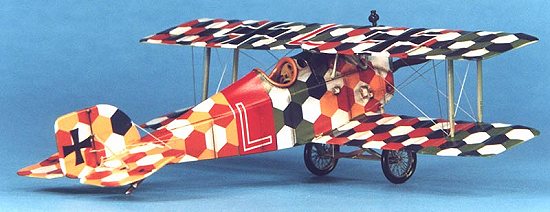 Only one decal option
is provided for Linke-Crawford’s aircraft flown with FLIK 60J. These markings
are very good with one exception. Reportedly FLIK 60J used a black fuselage band
as a squadron marking and not the red one supplied in the kit. Also, the red
decals are very translucent so it would be beneficial (and accurate) to paint
the black band instead. Of course I am much too lazy to do this so I went with
the red decals! At least I have an excuse, I didn’t know the red was that
translucent! After drying overnight, I wiped the decals off with a moist cloth
with Pollys Plastic Prep to remove any residue and after drying I shot a very
light coat of Future thinned with rubbing alcohol (50-50 mix) over the decals to
seal them.
Only one decal option
is provided for Linke-Crawford’s aircraft flown with FLIK 60J. These markings
are very good with one exception. Reportedly FLIK 60J used a black fuselage band
as a squadron marking and not the red one supplied in the kit. Also, the red
decals are very translucent so it would be beneficial (and accurate) to paint
the black band instead. Of course I am much too lazy to do this so I went with
the red decals! At least I have an excuse, I didn’t know the red was that
translucent! After drying overnight, I wiped the decals off with a moist cloth
with Pollys Plastic Prep to remove any residue and after drying I shot a very
light coat of Future thinned with rubbing alcohol (50-50 mix) over the decals to
seal them.
Next, a light coat of Polly S Flat Finish was shot to provide a surface for pastels. I then used pastels, and pastel pencils to lightly highlight the ribs and detail on the wings/tail surfaces and fuselage. I use Derwent pastels and pencils and they are quite easy to use, just lightly draw on the surface to be highlighted and blend with artists blending stump. A very nice, subtle effect can be achieved with these pencils that is much easier for me than dry brushing. Next I applied a heavy burnt umber oil wash to the wheels and engine undersurfaces and sealed everything with a light coat of Future.
|
FINAL CONSTRUCTION |
Construction of this kit was basically a decal job, so I didn’t assemble the wings and tail surfaces prior to decaling. Now onto the fun part, putting on this stuff without wrecking the decals! It actually went much easier than expected (except for the fact that I kept pulling a Scott and snapping off one of the stabilizers!), with the only problem being the interplane struts appear to be a tad bit too long forcing the bottom wing into a slight negative dihedral. The landing struts and axle were also installed without any difficulties.
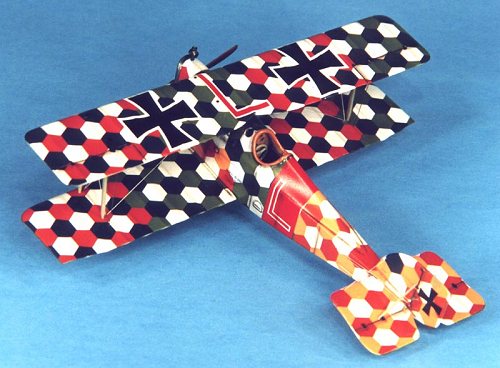 The PE wire wheels
and supplied rubber o-ring tires look absolutely cool! Only problem is, the
o-rings are slightly too large and the wire wheels won’t fit. A quick call for
help from the WWI Modeling List (http://pease1.sr.unh.edu/) provided an
incredibly easy solution from Candice Uhlir. She suggested building a rim from
thin styrene strip and placing it inside the o-ring. This was way too easy as
all I had to do was take the strip, cut it to approximate length, wrap it inside
the o-ring (to get the exact length), cut to fit, and then a dab of liquid
cement to join the ends together inside the o-ring. Took me all of five minutes
to make the rims! I then glued the wire wheels to the rim using plain old white
glue. For those not up to the challenge, a set of injected molded wheels and
lozenge decal coverings are provided.
The PE wire wheels
and supplied rubber o-ring tires look absolutely cool! Only problem is, the
o-rings are slightly too large and the wire wheels won’t fit. A quick call for
help from the WWI Modeling List (http://pease1.sr.unh.edu/) provided an
incredibly easy solution from Candice Uhlir. She suggested building a rim from
thin styrene strip and placing it inside the o-ring. This was way too easy as
all I had to do was take the strip, cut it to approximate length, wrap it inside
the o-ring (to get the exact length), cut to fit, and then a dab of liquid
cement to join the ends together inside the o-ring. Took me all of five minutes
to make the rims! I then glued the wire wheels to the rim using plain old white
glue. For those not up to the challenge, a set of injected molded wheels and
lozenge decal coverings are provided.
I installed some hypo tubing to simulate the gun barrel and after installing all the remaining "fiddly bits" it was time to complete the rigging. I use .006-fishing line painted silver and use a "through-hole" rigging method. I basically drill a hole with an #80 bit (the smallest, about .0135) all the way through the wing at each of my rigging exit points. I try to minimize the number of exit points and run as many lines through them when possible. After securing one end to a partially drilled hole (not all the way through) with superglue, I then run the line out through the exit hole. I weight the end of the line with a pair of hemostats to pull tight by letting it hang down and apply a small drop of superglue to secure it. Let cure for about 30 seconds and then unhook the hemostats and proceed to the next wire. Repeat until done! After letting the entire rigging cure for at least an hour, I then take a brand new Exacto blade and trim flush with the wing surface. I then sand the exit holes flush and apply a spot of touch-up paint to cover. That's it, simple, cheap, and fast. In addition, it also provides a small amount of structural integrity. I can rig a whole airplane in under an hour! Can't do that with wire!
Finally, several coats of Polly S Satin Finish was shot to achieve the semi-gloss finish common to most WWI aircraft.
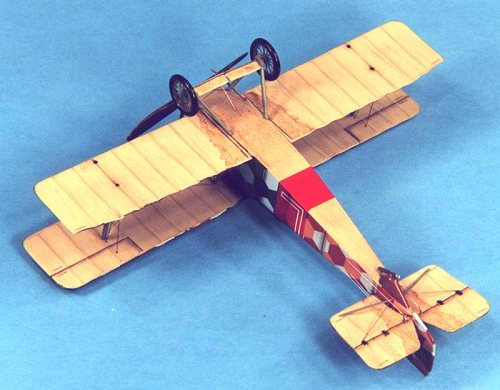
|
CONCLUSIONS |
I think the pictures speak for themselves regarding the quality of this kit. Outside of the extensive decaling needed (and the problems getting them over the raised detail), and the problem with the o-ring tires, this was an easy WWI build suitable for most modelers.
|
REFERENCES |
Albatros Productions LTD, Windsock Datafile #45, Aviatik D.I, $12.00
If you would like your product reviewed fairly and quickly, please contact me or see other details in the Note to Contributors.